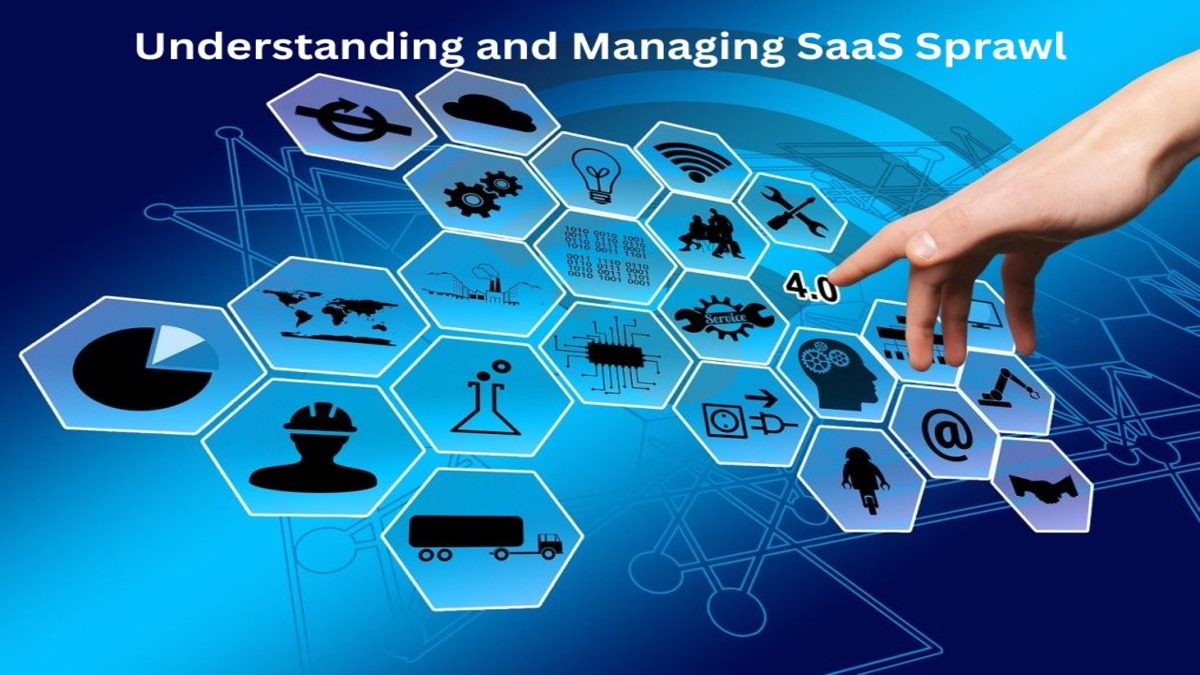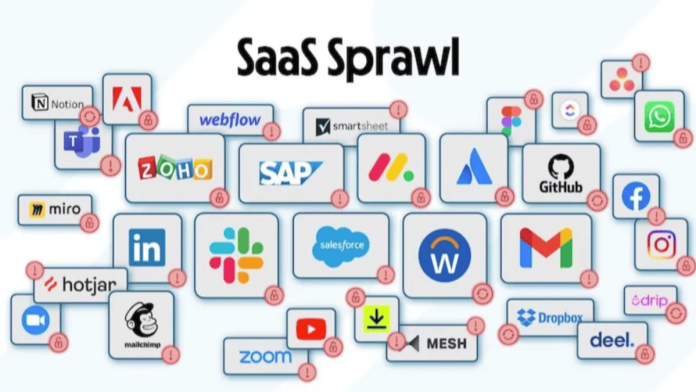In today’s digital age, Software as a Service (SaaS) has revolutionized how businesses operate. These cloud-based tools enable companies to be agile, scalable, and efficient, offering everything from project management to customer relationship management at the click of a button. However, this widespread SaaS adoption doesn’t come without its own set of challenges. Welcome to the world of what is SaaS sprawl.
Understanding and Managing SaaS Sprawl:

SaaS sprawl occurs when an organization uses a multitude of SaaS applications, often without a clear strategy or centralized control. This typically happens as different departments independently adopt various tools to meet their immediate needs. While this can initially boost productivity, it often spirals into a tangled web of subscriptions, redundant functionalities, and increased security risks.
Why does SaaS sprawl matter? Imagine a scenario where multiple teams are using different versions of the same tool, leading to inefficiencies and data silos. Not to mention, managing numerous subscriptions can become a financial nightmare, draining resources and affecting your bottom line. Additionally, with each new application, there’s a new avenue for potential security vulnerabilities, making it harder to protect your company’s sensitive data.
Understanding SaaS sprawl is the first step towards managing it effectively. In this article, we will delve deeper into the causes and impacts of SaaS sprawl and offer actionable strategies to keep it under control. Balancing innovation with oversight is crucial to reap the full benefits of SaaS while safeguarding your business’s efficiency and profitability.
The Causes of SaaS Sprawl: Understanding the Root Issues
SaaS sprawl refers to the unchecked proliferation of Software as a Service (SaaS) applications within an organization. This often leads to inefficiencies, increased costs, and difficulty managing software assets. Understanding the root causes of SaaS sprawl is crucial for businesses aiming to maintain control over their digital infrastructure.
- Decentralized Purchasing Impact: One primary cause of SaaS sprawl is the decentralized purchasing of software. With various departments independently acquiring and subscribing to different SaaS applications, there’s often a lack of centralized oversight. This can result in duplicate services, unused subscriptions, and fragmented tools that don’t integrate well.
- Easy SaaS Accessibility: Another contributing factor is the ease of access to SaaS solutions. While this accessibility is a strength, it also means employees can sign up for new software without proper vetting or managerial approval. Without a clear procurement process, oversight diminishes, resulting in overlapping functionalities and wasted resources.
- Inadequate SaaS Documentation: Poor documentation and management of current SaaS subscriptions exacerbate the issue. Many organizations lack a comprehensive inventory or catalog of all their SaaS subscriptions. This oversight makes it challenging to track usage, manage renewals, or identify redundant services.
- Unchecked SaaS Adoption: Moreover, rapid scaling and growth often lead companies to adopt numerous SaaS applications quickly, sometimes without thorough evaluation. Teams may prioritize immediate functionality over strategic integration, leading to a patchwork of services that are challenging to consolidate later.
Understanding these root causes highlights the need for better governance, centralized control, and strategic planning in software procurement. Addressing SaaS sprawl is not just about controlling costs; it’s about creating a cohesive and efficient software ecosystem that supports the organization’s goals
The Impact of SaaS Sprawl on Business Efficiency and Costs
SaaS sprawl can have significant consequences for a business, affecting both efficiency and costs. When companies adopt numerous Software-as-a-Service applications without proper oversight, it often leads to redundant tools and overlapping functionalities. This unregulated growth can make the tech stack overly complex, leading to inefficiencies in workflows as employees struggle to manage multiple platforms.
-
Increased Operational Costs
Moreover, SaaS sprawl can substantially inflate operational costs. Subscription fees for underutilized or duplicate applications accumulate, eating into the company’s budget. Without a clear inventory or usage strategy, businesses can inadvertently pay for software licenses they don’t need. Over time, these seemingly small expenses add up, affecting the bottom line.
-
Data Fragmentation and Decision-Making Challenges
Another critical issue is data fragmentation. Different SaaS applications may store data in separate silos, making it difficult to gain a unified view of the business. This fragmentation can hinder decision-making, as stakeholders have to compile data manually from various sources, increasing the chances of errors and inefficiencies.
-
Security and Compliance Risks
Security and compliance risks also rise with SaaS sprawl. With numerous applications in use, ensuring that all of them meet security standards and comply with regulations becomes increasingly challenging. Unsecured applications create vulnerabilities, heightening the risk of data breaches.
-
Mitigating the Impact of SaaS Sprawl
Addressing SaaS sprawl is essential for maintaining cost control, ensuring efficient operation, and safeguarding data integrity. By taking proactive measures to manage SaaS usage effectively, businesses can mitigate these impacts and streamline their digital ecosystems for better performance.
Strategies to Combat and Manage SaaS Sprawl
Effectively managing SaaS sprawl is crucial to gaining control over your software expenses and ensuring your tech stack works cohesively. Here are some proven strategies to combat and manage SaaS sprawl efficiently:
- Conduct Regular Audits: Conducting frequent audits of all the SaaS applications in use across the organization provides insightful data. This practice helps you identify redundant tools, overlapping functionalities, and unused licenses, allowing you to eliminate wasteful spending and streamline operations.
- Centralize SaaS Management: Establishing a centralized system for managing all SaaS subscriptions can simplify oversight. Use a dedicated platform or portal where all subscriptions, users, and billing information are recorded. This approach ensures there is no duplication and that all applications are documented and tracked.
- Implement Clear Policies: Creating transparent and stringent policies on procurement and approval of SaaS applications reduces the chances of unauthorized purchases. Ensure that any new tool goes through a standard approval process, preferably involving IT and finance departments, to assess its necessity and compatibility with existing systems.
- Encourage Communication and Collaboration: Facilitate open communication between departments regarding the software tools in use. Regular inter-departmental meetings can serve as a platform to evaluate current tools, share feedback, and suggest improvements. Collaboration ensures everyone is on the same page and helps to avoid redundant app adoption.
- Leverage Data Analytics: Using analytics to tap into usage data can reveal insightful trends and patterns in software consumption. This data-driven approach identifies underused applications and can inform decisions on renewing, upgrading, or canceling subscriptions.
Deploying these strategies can help you regain control over your SaaS ecosystem, reduce costs, and enhance overall operational efficiency. Addressing SaaS sprawl now ensures your business remains agile and prepared for future growth.
Tools and Technologies to Help Control SaaS Sprawl
In the fight against SaaS sprawl, leveraging the right tools and technologies can significantly streamline your efforts.
-
SMPs:
One effective solution is the use of SaaS management platforms (SMPs). These platforms offer comprehensive dashboards that help you track all the software subscriptions within your company, providing valuable insights into usage, costs, and integration.
-
CASB:
Another essential tool is cloud access security brokers (CASBs). These security solutions act as intermediaries between users and cloud service providers, helping you manage and secure the data flow. CASBs allow you to monitor user activity, enforce security policies, and provide detailed analytics, thereby offering a higher level of control over your SaaS landscape.
-
IAM:
Identity and Access Management (IAM) systems are also crucial in controlling SaaS sprawl. They ensure that only authorized users have access to specific applications, reducing the risk of shadow IT—applications used without IT’s knowledge or approval. With IAM, you can centralize authorization policies and manage user roles effectively, reducing unnecessary license costs and potential security risks.
-
Automated Subscription Management:
Additionally, consider implementing automated subscription management tools. These tools help you identify redundant or underutilized subscriptions, allowing you to cancel unnecessary services easily. Automation minimizes manual tracking errors and helps maintain an up-to-date inventory of your SaaS applications.
-
Leveraging Integration Platforms:
Lastly, don’t underestimate the value of integration platforms. Tools like iPaaS (Integration Platform as a Service) can seamlessly connect disparate SaaS applications, facilitating smoother data flow and enhancing productivity.
By investing in these tools and technologies, businesses can gain better control over their SaaS environment, ultimately reducing costs and improving operational efficiency. Addressing SaaS sprawl proactively can set the foundation for future growth and success.
Conclusion: The Importance of Addressing SaaS Sprawl for Future Success
SaaS sprawl is more than just an IT issue; it’s a business challenge with significant implications. If left unchecked, the uncontrolled proliferation of software-as-a-service (SaaS) applications can drain financial resources, reduce efficiency, and introduce data security risks. As businesses increasingly rely on digital tools to drive growth and innovation, managing SaaS sprawl becomes crucial.
-
Streamlining SaaS for Efficiency
By addressing SaaS sprawl, businesses can streamline their operations, ensuring that every application in their tech stack serves a clear purpose and delivers value. This oversight not only reduces redundant costs but also enhances productivity by ensuring teams use integrated, effective tools rather than juggling multiple overlapping software.
-
Proactive SaaS Management Strategies
Adopting a proactive approach to SaaS management is essential. Regular audits, centralized control, and leveraging specialized tools can provide visibility into your SaaS landscape, helping to eradicate inefficiencies. Moreover, fostering a culture of awareness and accountability around SaaS usage can empower employees to make informed decisions, contributing to a lean and efficient digital environment.
-
Building a Sustainable SaaS Future
Looking ahead, businesses that effectively control SaaS sprawl will be better positioned for sustainable growth and resilience. By curating a streamlined, cost-effective suite of applications, they can enhance operational agility and maintain a robust security posture. In the rapidly evolving digital landscape, addressing SaaS sprawl is not just about optimizing current operations, but also about building a foundation for future success.
Read More: Top 10 Popular SaaS Marketing Blogs in 2024

